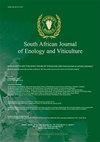Ascorbic Acid Derivatives in the Sauvignon Blanc Cultivar (Vitis vinifera L.) During Berry Development in the Wellington and Elgin Regions
IF 1.1
4区 农林科学
Q4 FOOD SCIENCE & TECHNOLOGY
引用次数: 1
Abstract
The exposure of grapevines to unfavourable conditions such as drought, high or low temperature and pathogenic attack increases the production of reactive oxygen species, thus inducing oxidative stress. One of the most important non-enzymatic antioxidants is ascorbic acid, which is used by plants to protect themselves against these toxic oxygen intermediates. DHA, DKG and threonate are ascorbic acid metabolites that are found during ascorbic acid catabolism. This study was done in two regions, the one in Wellington, classified as a warmer climate, and the other in Elgin, classified as a cooler climate. In each region, two Sauvignon blanc vineyard blocks were selected, with north to south and east to west row directions. Vines were monitored during the growing season to investigate the trends in the development of ascorbic acid metabolites in both regions. Canopy management practices were done at different ripening stages. Grape berries were sampled at different phenological stages according to the Eichhorn Lorenz scale: E-L 32, E-L 34, E-L 35, E-L 37 and E-L 38. Ascorbic acid derivative concentrations in the two regions varied significantly in that Elgin showed higher concentrations than Wellington at E-L 32 and E-L 38. Both the cool and warm regions had high concentrations of threonate, with no significant difference among stages of ripeness. The DHA, DKG and threonate levels were the highest at the E-L 32 phenological stage for both regions, with no significant differences among the other phenological stages, especially for DHA derivative concentrations. No significant effect on the DHA, DKG and threonate levels of the grapes was observed between row directions in each region.威灵顿和埃尔金地区浆果发育过程中长相思品种(Vitis vinifera L.)中的抗坏血酸衍生物
葡萄藤暴露在干旱、高温或低温等不利条件下以及病原攻击会增加活性氧的产生,从而诱导氧化应激。抗坏血酸是最重要的非酶抗氧化剂之一,它被植物用来保护自己免受这些有毒氧中间体的侵害。DHA、DKG和苏酸是抗坏血酸代谢产物,在抗坏血酸分解代谢过程中发现。这项研究是在两个地区进行的,一个在惠灵顿,被归类为温暖的气候,另一个在埃尔金,被归类为凉爽的气候。在每个地区,选择了两个长相思葡萄园块,从北到南和从东到西的行方向。在生长季节对葡萄藤进行监测,以调查两个地区抗坏血酸代谢物的发展趋势。在不同的成熟期进行冠层管理。采用Eichhorn Lorenz分级法对不同物候阶段的葡萄果实进行取样:E-L 32、E-L 34、E-L 35、E-L 37和E-L 38。两个地区的抗坏血酸衍生物浓度差异显著,Elgin在e - l32和e - l38的浓度高于Wellington。冷暖地区苏氨酸浓度均较高,成熟期差异不显著。两个地区的DHA、DKG和苏酸含量均在e - l32物候期最高,其他物候期差异不显著,特别是DHA衍生物的含量差异不显著。不同行向对葡萄DHA、DKG和苏酸含量无显著影响。
本文章由计算机程序翻译,如有差异,请以英文原文为准。
求助全文
约1分钟内获得全文
求助全文
来源期刊
CiteScore
2.50
自引率
7.70%
发文量
1
审稿时长
>36 weeks
期刊介绍:
The South African Journal of Enology and Viticulture (SAJEV) publishes full-length original Research Papers, Research Notes and Review Papers on all subjects related to enology and viticulture. The SAJEV does not accept articles published in, or submitted to, other journals.

 求助内容:
求助内容: 应助结果提醒方式:
应助结果提醒方式:


